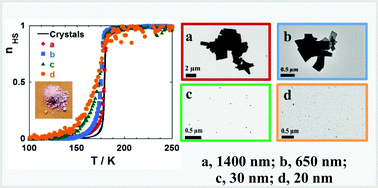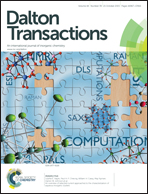Nanocrystals of Fe(phen)2(NCS)2 and the size-dependent spin-crossover characteristics†
Abstract
We report on the size reduction of the neutral Fe(phen)2(NCS)2 prototypical compound exhibiting a cooperative spin-crossover associated with a first-order phase transition (at ca. 176 K). We use the [Fe(phen)3](NCS)2 ionic precursor and the solvent-assisted precipitation technique to prepare an array of crystalline objects with sizes varying over two orders of magnitude (from 15 up to 1400 nm). TEM, X-ray diffraction and IR measurements provide evidences for the formation of particles of neutral and ionic species, which results from the interplay between the relevant chemical equilibrium and the reaction kinetics (ligand extraction, complex precipitation), and the modulation of the latter by physico-chemical parameters. A thermal transformation of diamagnetic nanocrystals of [Fe(phen)3](NCS)2 leads to spin-crossover particles of Fe(phen)2(NCS)2 of a comparable size. Powders of nano-, micro- and polycrystals of Fe(phen)2(NCS)2 present X-ray diffractograms typical of the so-called polymorph II. The importance of size effects on the cooperative spin-crossover process was probed with magnetic, Mössbauer, Raman and IR spectroscopic measurements. Each sample exhibits spin-state switching of the Fe(II) ions. The salient features are: a cooperativity preserved at the micrometric scale, a very limited downshift of the transition temperature and an asymmetric spreading of the thermal process (over ca. 100 K) with the size reduction. At temperatures close to room temperature, the process appears to be quasi complete whatever the size of the samples. This result, extracted from Raman data, was confirmed by Mössbauer measurements in the case of the largest objects (LS residue <5–10% for bulk and microparticles). Below 150 K, a very efficient low-spin to high-spin photoexcitation was induced by the Raman laser beam in all the samples which prevents the extraction of the high-spin fraction in this temperature range. However variable temperature IR spectra of the 29 nm particles indicate that the HS residue, that is close to zero in the case of microparticles, does not drastically increase (<30%) for the smallest particles. The processing of a number of related spin-crossover compounds in the form of nanoparticles may be achieved with this general approach.


 Please wait while we load your content...
Please wait while we load your content...